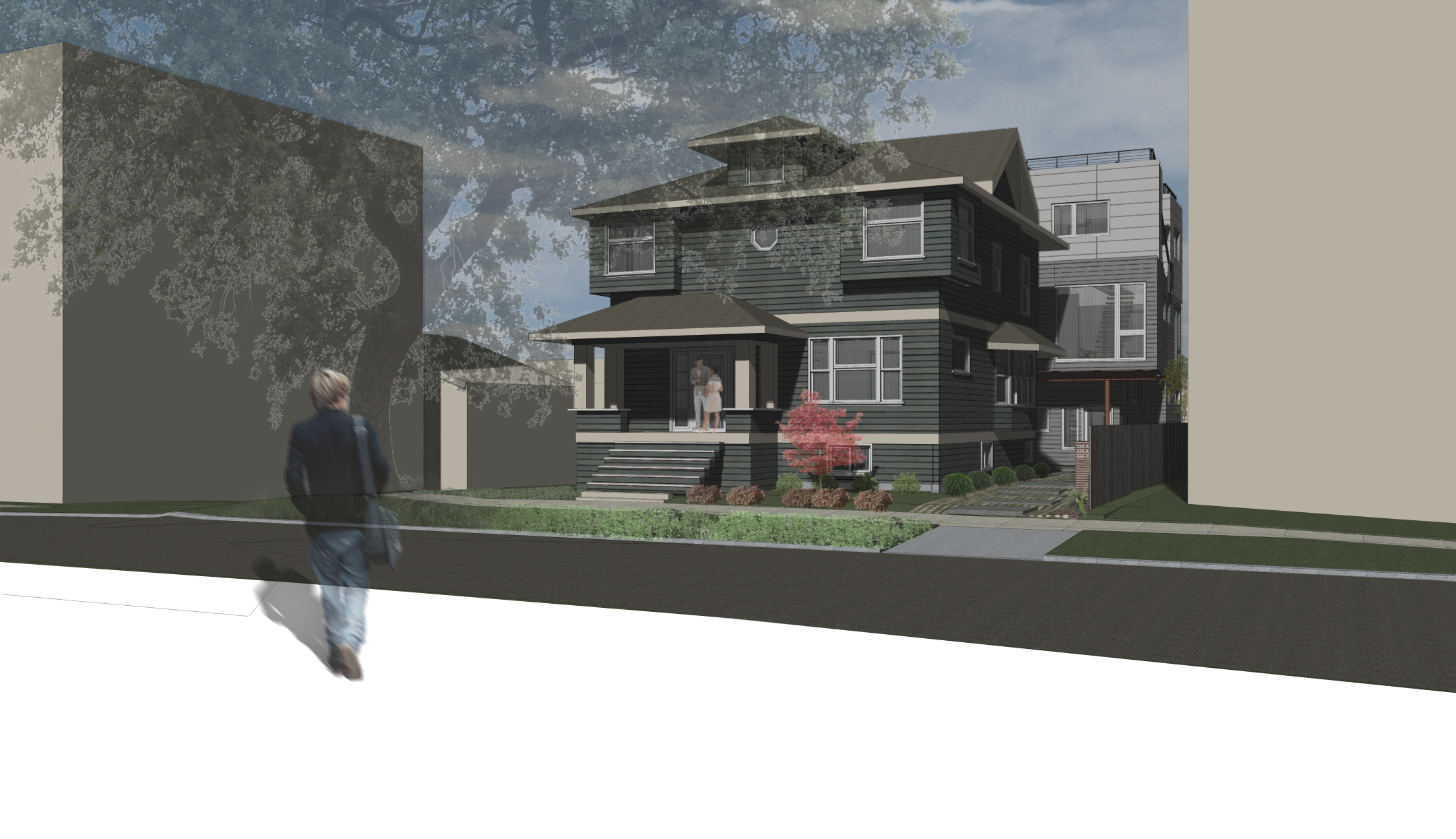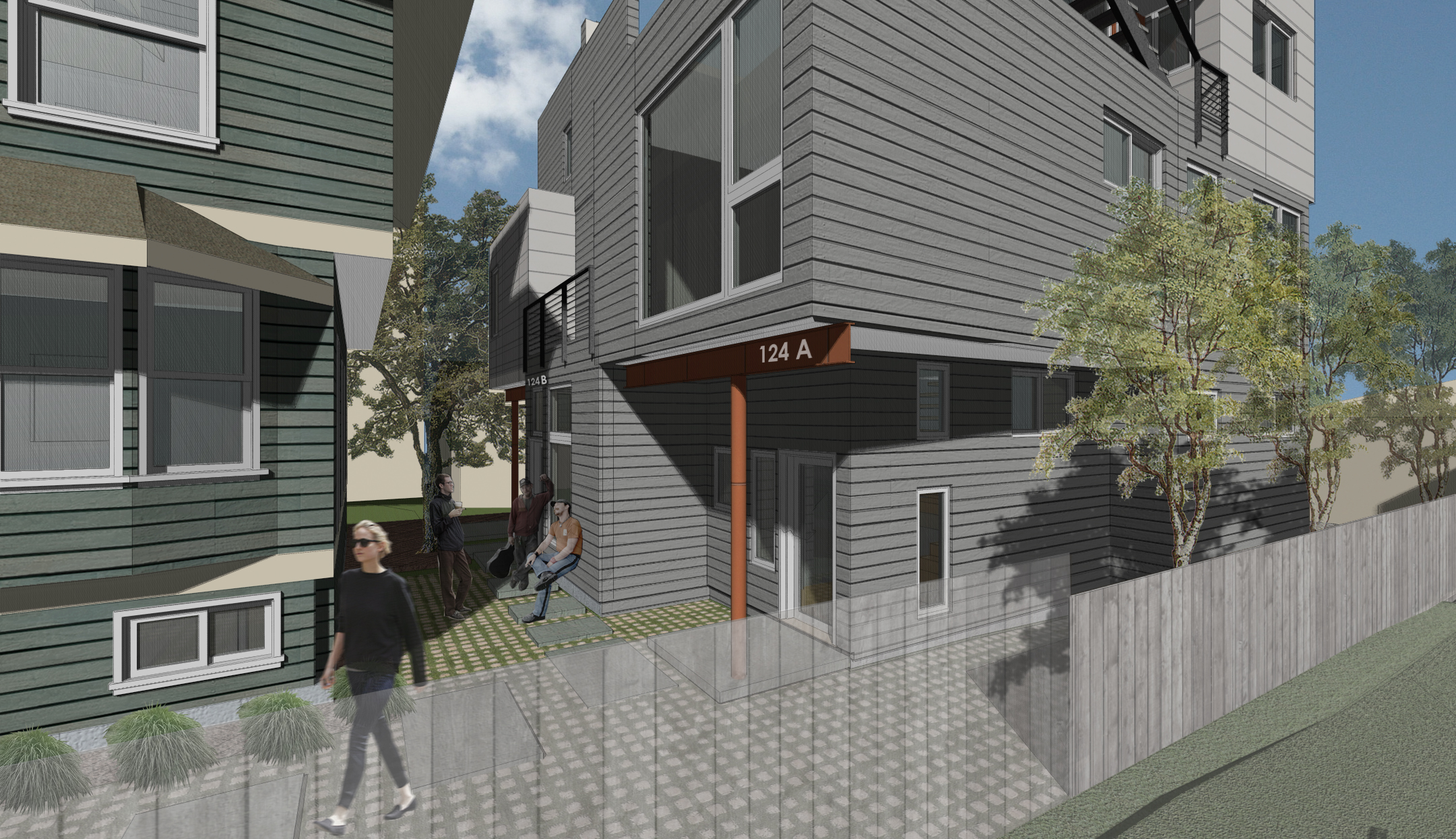 A pair of Seattle developers are proving that saving Capitol Hill’s unique stock of old homes doesn’t have to be a sentimental fight against the tides of demographic change. If you’re willing to embrace higher density, rethink urban communities, and move a house or two along the way, keeping character can be a profitable pursuit.
A pair of Seattle developers are proving that saving Capitol Hill’s unique stock of old homes doesn’t have to be a sentimental fight against the tides of demographic change. If you’re willing to embrace higher density, rethink urban communities, and move a house or two along the way, keeping character can be a profitable pursuit.
The latest project from Capitol Hill architect Brad Khouri and developer Graham Black at 122 18th Ave. E involves saving a 2,500 square-foot home built in 1903 and adding three townhouses in the back yard. To do it, Khouri and Black will be moving the existing home eight feet towards the street and cutting off the back patio and laundry room.
 “It’s a hedge against risk from a development perspective,” Black said of new projects that save old homes. “In a market that has real town home scarcity, it’s not going to be the best financial return, but it will be a good financial return and we wouldn’t be doing it if there wasn’t a nice return.”
“It’s a hedge against risk from a development perspective,” Black said of new projects that save old homes. “In a market that has real town home scarcity, it’s not going to be the best financial return, but it will be a good financial return and we wouldn’t be doing it if there wasn’t a nice return.”
The new townhouses will be 1,600-1,700 square-feet and priced around $500,000; the existing home will be priced around $700,000. Khouri recently submitted the master drawings to the city for design review and hopes to have tenants in the old home and new town homes by the end of next year.
“It really great way to find that the balance of retaining character and historical reference, and finding that density to make Seattle an exciting, and maybe more chaotic, place to live,” Black said.
Black said the property had been on his radar for a long time, especially once discussions about changes to the city’s zoning code got underway three years ago. Khouri, who worked on the zoning code revamp for several years, said the changes put the bottom line in the black for these types of save-and-build projects.
In the new codes, existing structures don’t count against density or total floor area allowed on the parcel. Parking requirements were removed for urban areas, set backs were eased, and the new regs allow for communal space on single parcels.
“This is a great project where we can demonstrate for the development community and city how well this carrot works,” Khouri said.
Beyond the zoning changes, Black said building new structures on properties with existing homes makes sense. Turns out the bankers like it, too.
“From a bankers perspective, a large portion of their collateral is that existing house, so they don’t have to swallow quite as hard if that house is staying up,” Black said.
The architect-developer duo have collaborated on five projects in Capitol Hill. Khouri and his family now live on their second save-and-build project at 19th and Pine, where a duplex was built in the back yard.
 “We could live onsite in the existing structure while working on a project in the driveway or the yard,” Khouri said. “It’s impacted in a positive way, the house is part of a community that it wasn’t before. The house loses a little bit of value, sure, but that value is attributed to a new project onsite. It’s a more sound way to speculate.”
“We could live onsite in the existing structure while working on a project in the driveway or the yard,” Khouri said. “It’s impacted in a positive way, the house is part of a community that it wasn’t before. The house loses a little bit of value, sure, but that value is attributed to a new project onsite. It’s a more sound way to speculate.”
And if your curious just how one goes about moving a 2,500 square-foot house, so were we. There are several companies in Seattle that specialize in house moving. Here’s the basic idea: Slip steel beams under the structure of the home, lift it a few feet with hydraulic house lifting jacks the size of semi trucks, slide in big rollers, pour the new foundation, roll the house over, re-brace with the jacks and lower it down.
“Brad and I are banking that it will be a pretty quick and smooth operation,” Black said. No date has been set on the house move, but Black said neighbors are welcome to come out and see it happen.



who said capitol hill was no longer affordable?
I would have no hesitation dropping 700k on a house so a bunch of low income people could live in those 500k townhomes in the back.
The only thing that would make this set up even more appealing is having apodments built in back.
ahhh, I see… Developers working with the City to change zoning codes so they can make even more money!
I almost bought that house and part of its appeal was the large backyard, it was just a little over priced.
It isn’t about saving a 1905 house, it’s about maximizing $/sq-ft for these guys. To me, a bad developement and idea.
People will complain about anything. I’m glad that this nice old house is being saved and not torn down. End of story.
Including complaining about complaining. End of story.
Somehow I knew a post like this would show up early. Since when was buying a home in Capitol Hill cheap?
We’ll have empirical evidence of whether it’s a bad idea or not when they go on the market. If they don’t sell, you’ll have your answer. I have a feeling they will.
Also, they specifically said this is not the best financial return. Just tearing down the place and building more townhomes almost certainly would have made them more money, and what’s wrong with making money off a project like this anyway? It’s a great mix of preservation, infill development, and a diversification of the housing stock. I really don’t see what’s not to like.
The key point for me is that great backyard that now has to accommodate 3 large town homes. Do we really need to build on every postage sized parcel of land? Hasn’t Cap Hill met its density requirements already?
Part of what drew me to the Hill was the more suburban feel to this part of the city. I’ve already lived in NYC, and I don’t want that again. Seriously, how much is too much?
Shanedphillips, I think your comment is flawed. Yes, the “market” will eventually determine if a new project is economically viable or not, but this can take some time, and by then we are stuck with ugly buildings which do not complement the surrounding neighborhood. If, for example, “apodments” turn out to be unpopular and difficult to rent (economically un-viable), there will be a number of them built before this becomes apparent.
Also, I disagree that economic viability should be the only criterion as to whether something gets built or not. Design is the most important thing, and that’s why the design review is so important, and which unfortunately is lacking for the apodments.
I’m against this. Its horrible. “Saving homes…” pft.
For one, this isn’t even a post about apodments. And frankly, the odds that any new units being built won’t actually be rented out/bought is tiny, barring another major recession or something. Developers do their homework like any other investor and aren’t going to build something they’re not extremely confident will make them money (i.e., sell). I disagree that design is the most important thing – it’s probably tied for most important with lots of stuff. Sure, if you build something completely, disgustingly ugly then suddenly design becomes very important, just like if you make buildings that are so unappealing functionally that no one wants to live in them.
The fact is that we’re talking about building a very small number of additional units relative to the existing housing stock and open space in Capitol Hill. There are thousands of single family homes, and a few of them are having their space used more densely. A very few.
Community input matters, but I again return to the fact that this is a great combination of preservation, infill, and novel design. I don’t think the only options for our neighborhood should be large condo-style buildings or single family homes, where anything that doesn’t meet those standards is shut down. We live in almost the exact center of a very quickly growing city and we’re getting a lot of amenities to go along with all our new residents – amazing new transit, many new restaurants, stores, and jobs, and an even more vibrant community. Embrace it.
Developers do their homework?
The Sanctuary
The townhomes on 14th between Thomas and Harrison
That’s just two I can recall off the top of my head where developers didn’t do their homework.
I don’t know anything about the one on 14th (feel free to link me to some information though – all I can find is something from just the beginning of this year which seems too early to have any data from), but Sanctuary is exactly what I was talking about with a recession. They bought it right at the peak of the housing market and tried to sell right at the bottom. They were no different from basically any other developer at the time. Like I said, barring another recession, these things tend to be pretty sure bets.